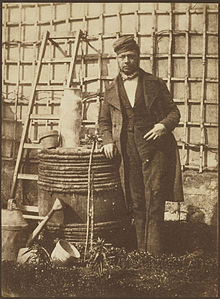Hippolyte Bayard
| Hippolyte Bayard | |
|---|---|

Self portrait, salt print (1847)
|
|
| Born | 20 January 1801 France |
| Died | 14 May 1887 |
| Nationality | French |
| Known for | Photography |
| Notable work | Self Portrait as a Drowned Man |
| Website | http://www.getty.edu/art/gettyguide/artMakerDetails?maker=1876 |
Hippolyte Bayard (20 January 1801 – 14 May 1887) was a French photographer and pioneer in the history of photography. He invented his own process known as direct positive printing and presented the world's first public exhibition of photographs on 24 June 1839. He claimed to have invented photography earlier than Louis-Jacques Mandé Daguerre in France and William Henry Fox Talbot in England, the men traditionally credited with its invention.
Bayard experimented with the new medium taking photos of plant speciments, statuary (including posing with them for self-portraits), street scenes, urban landscapes, architectural photos, and portraits. He photographed prominent figures and an ordinary worker. He also advocated combination printing and was one of the founders of a photo society.
While working as a civil servant, Bayard experimented with photography. He developed his own method of producing photos called the direct positive process. It involved exposing silver chloride paper to light, which turned the paper completely black. It was then soaked in potassium iodide before being exposed in a camera. After the exposure, it was washed in a bath of hyposulfite of soda and dried.
The resulting image was a unique photograph that could not be reproduced. Due to the paper's poor light sensitivity, an exposure of approximately twelve minutes was required. Using this method of photography, still subject matter, such as buildings, were favoured. When used for photographing people, sitters were told to close their eyes so as to eliminate the eerie, "dead" quality produced due to blinking and moving one's eyes during such a long exposure.
In the summer of 1851, along with photographers Édouard Baldus, Henri Le Secq, Gustave Le Gray, and O. Mestral, Bayard travelled throughout France to photograph architectural monuments at the request of the Commission des Monuments Historiques.
Bayard was persuaded to postpone announcing his process to the French Academy of Sciences by François Arago, a friend of Louis Daguerre, who invented the rival daguerreotype process. Arago's conflict of interest cost Bayard the recognition as one of the principal inventors of photography. He eventually gave details of the process to the French Academy of Sciences on 24 February 1840 in return for money to buy better equipment.
...
Wikipedia
